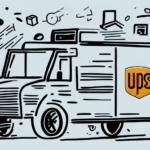Does UPS Offer Insurance? A Comprehensive Guide
When shipping packages with UPS, many people wonder whether the company offers insurance. The good news is that UPS does offer shipping insurance for customers who want to protect their packages against loss or damage in transit. In this comprehensive guide, we'll explore everything you need to know about UPS shipping insurance, from the basics to the process for purchasing and making a claim.
Understanding the Basics of Shipping Insurance with UPS
Shipping insurance provides financial protection against unforeseen events, such as loss or damage during transit. UPS offers insurance coverage for packages that are lost, damaged, or stolen while in transit, covering the full value of the package, including shipping costs and any associated fees.
UPS offers different levels of insurance coverage based on the value of your package. For packages valued at less than $100, UPS automatically provides basic coverage at no additional cost. For packages valued at more than $100, purchasing additional insurance coverage is necessary to ensure full protection.
Proper packaging is crucial when shipping with UPS to minimize the risk of damage during transit. This includes using sturdy boxes, adequate cushioning materials, and ensuring the package is properly sealed. In the event that your package is lost or damaged, it is important to file a claim with UPS as soon as possible to receive appropriate compensation.
Determining If Your Package Needs Insurance
Whether you need to purchase insurance for your UPS package depends on the value and nature of the contents. If your package contains items that are relatively inexpensive and easily replaceable, insurance may not be necessary. However, for valuable or irreplaceable items, purchasing insurance is recommended to protect your investment.
Consider the shipping method and carrier as well. Some carriers include a certain amount of insurance coverage in their shipping fees, while others offer additional insurance options for an extra cost. Additionally, certain shipping methods may increase the risk of damage or loss, making insurance a wise investment.
Eligible Packages for UPS Insurance
Most types of packages are eligible for UPS insurance, including domestic and international shipments. However, there are restrictions on what can be insured. Hazardous materials and other dangerous goods cannot be insured through UPS. Additionally, packages shipped via UPS SurePost or UPS Mail Innovations are not eligible for insurance.
The amount of insurance coverage available varies based on the value of the contents. UPS offers insurance coverage up to $50,000 for domestic shipments and up to $100,000 for international shipments. Customers can also purchase additional insurance coverage for high-value items.
When filing a claim for a lost or damaged package, customers must provide proof of the package's value and evidence of the damage or loss, such as the original invoice or receipts. Keeping all relevant documentation and tracking information is recommended in case a claim needs to be filed.
The Cost of UPS Shipping Insurance: Is It Worth It?
The cost of UPS shipping insurance varies based on the value of your package, destination, and shipping method. Typically, the cost is a small percentage of the overall package value. Deciding whether to purchase insurance depends on the value of your package contents and your comfort level with the associated shipping risks.
It's important to note that UPS shipping insurance only covers the value of the package contents, excluding any sentimental or emotional value. Additionally, certain items like perishable goods or prohibited items are not covered by insurance.
If you decide to purchase UPS shipping insurance, carefully review the terms and conditions to understand what is and isn't covered. You may also consider alternative shipping options, such as using a different carrier or enhancing packaging and security measures to reduce the risk of damage or loss during transit.
How to Purchase UPS Shipping Insurance
There are several ways to purchase shipping insurance through UPS. You can add insurance when creating a shipping label on UPS.com, purchase at a UPS location during package drop-off, or add insurance via UPS WorldShip software.
Shipping insurance costs are based on the declared value of your package; higher values result in higher insurance costs. UPS also offers additional services such as signature confirmation and adult signature confirmation for an extra fee.
To file a claim for a lost or damaged package, you can do so online through UPS.com by providing information like the tracking number, package contents, and proof of value. UPS will investigate and provide a resolution within the specified timeframe.
What’s Covered Under UPS Shipping Insurance?
UPS shipping insurance covers the full value of your package, including the cost of shipping and other associated fees. Coverage includes damage during shipping, loss, or theft while in transit. However, exclusions apply, such as damage caused by improper packaging or insufficient labeling.
UPS shipping insurance also offers additional services like declared value coverage, allowing you to declare a higher package value than its actual worth, providing extra protection in case of loss or damage. Accessorial coverage includes protection for items such as perishable goods, fine art, and jewelry.
When filing a claim for a lost or damaged package, UPS requires documentation such as the original invoice, proof of value, and evidence of damage. Keeping these documents is recommended in case you need to file a future claim.
UPS Shipping Insurance Claim Process: Step-by-Step Guide
If you need to make a claim under your UPS shipping insurance policy, the process is straightforward. Follow these steps:
- Documentation of Package Value: Provide an invoice or receipt that outlines the value of the package contents.
- Evidence of Loss or Damage: Submit photos or other documentation that show the loss or damage to the package.
- Complete Claim Form: Fill out a claim form and submit it to UPS for processing.
Note that UPS has specific time limits for filing claims: within nine months of the delivery date for domestic shipments, and within 60 days for international shipments. UPS may require an inspection of the package and its contents before processing your claim.
If approved, UPS will reimburse you for the declared value of the package, up to the maximum coverage amount of your insurance policy. If your claim is denied, you have the option to appeal the decision or take legal action to recover your losses.
Tips for Preventing Damage and Loss During Shipping
While UPS shipping insurance provides financial protection against unforeseen events, preventing damage or loss is always preferable. Here are some tips to minimize risks during shipping:
- Proper Packaging: Use appropriate padding and cushioning materials to protect your items.
- Correct Labeling: Ensure your package is clearly labeled with the correct address and shipping information.
- Choose the Right Shipping Method: Consider the fragility and value of your items, as well as the shipping distance, to select a method that offers the appropriate level of protection and tracking.
- Insure Your Package: For valuable or irreplaceable items, insure your package for its full value.
By following these precautions, you can help ensure that your package arrives safely and intact at its destination.
Comparing UPS Shipping Insurance with Other Carriers
UPS is not the only shipping carrier that offers insurance coverage for packages. Other carriers like FedEx and the United States Postal Service (USPS) also provide insurance options. When selecting a carrier and insurance coverage, compare the costs and benefits of each option to ensure you're getting the best value for your money.
Level of Coverage: While all carriers offer some level of coverage, the amounts can vary significantly. For example:
- UPS offers up to $100 of coverage for free.
- FedEx provides up to $100 of coverage for an additional fee.
- The USPS includes up to $50 of coverage for free, with options to purchase additional coverage up to $5,000.
Understanding these differences can help you make an informed decision based on your shipping needs and the value of your packages.
Common Misconceptions About Shipping Insurance with UPS
Several misconceptions surround UPS shipping insurance:
- Automatic Coverage: Many believe UPS automatically provides insurance for all packages. In reality, insurance is an optional service that must be purchased separately.
- All Package Types are Insured: Some assume all types of packages are eligible for insurance, but restrictions apply. Hazardous materials and dangerous goods cannot be insured through UPS.
- Full Value Coverage: There is a misconception that UPS insurance covers the full package value. However, UPS has maximum liability limits depending on the service type and destination. Always check the policy terms for coverage limits and exclusions.
- Simplistic Claims Process: Some think filing a claim is straightforward, but it can be complex and time-consuming, requiring thorough documentation and evidence to support the claim.
In conclusion, UPS does offer insurance coverage for packages, and several factors should be considered when deciding to purchase insurance. By understanding the basics of shipping insurance and following best practices for packaging and labeling, you can minimize risks and protect your packages during transit.




















